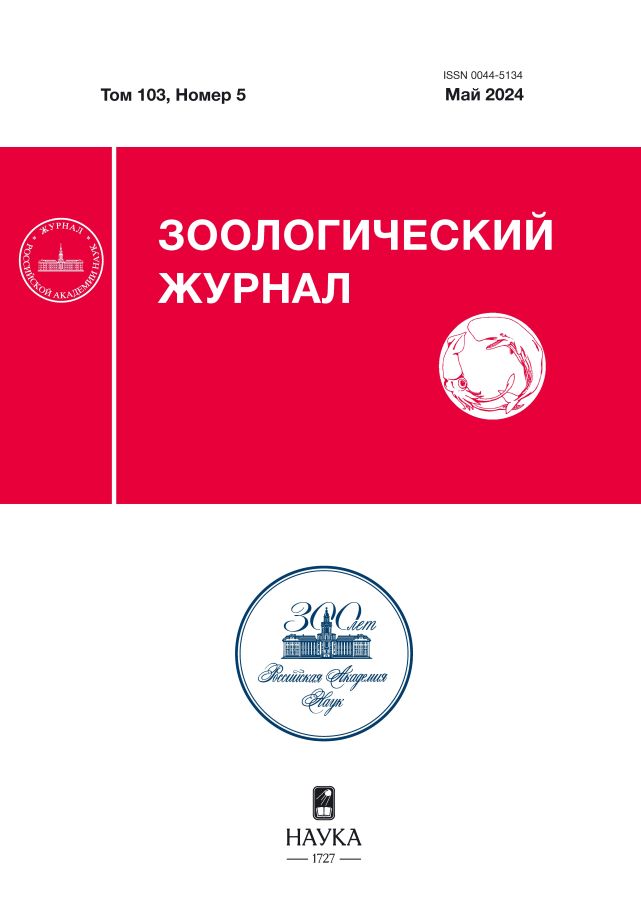Пресноводные губки (Porifera, Spongillidae) в Субарктике Западной Сибири
- Авторы: Герасимова А.А.1, Шарапова Т.А.1, Герасимов А.Г.2
-
Учреждения:
- Федеральное государственное бюджетное учреждение науки Федеральный исследовательский центр Тюменский научный центр СО РАН
- Федеральное государственное бюджетное научное учреждение “Всероссийский научно-исследовательский институт рыбного хозяйства и океанографии”
- Выпуск: Том 103, № 5 (2024)
- Страницы: 3-10
- Раздел: Статьи
- URL: https://permmedjournal.ru/0044-5134/article/view/654279
- DOI: https://doi.org/10.31857/S0044513424050011
- EDN: https://elibrary.ru/usphud
- ID: 654279
Цитировать
Полный текст
Аннотация
При изучении зооперифитона водоемов и водотоков Субарктики Западной Сибири были выявлены пресноводные губки. Исследования проводили на участках южной тундры и лесотундры, которые, в свою очередь, условно были поделены на три зоны: западную, центральную и восточную. Всего исследованиями было охвачено 40 водоемов и водотоков. Найдено три вида губок – Spongilla lacustris, Ephydatia muelleri и Ephydatia fluviatilis. Наиболее часто встречается S. lacustris, реже – E. muelleri и единично – E. fluviatilis. Максимальные значения количества видов и их встречаемости отмечены в водоемах лесотундры. Проведены линейные промеры и размерный анализ геммул и элементов скелетной системы губок. Выявлена тенденция уменьшения размеров скелетных структур исследуемого биологического материала в сравнении с литературными данными.
Ключевые слова
Полный текст
Об авторах
А. А. Герасимова
Федеральное государственное бюджетное учреждение науки Федеральный исследовательский центр Тюменский научный центр СО РАН
Email: nstya_vid@mail.ru
Россия, Тюмень
Т. А. Шарапова
Федеральное государственное бюджетное учреждение науки Федеральный исследовательский центр Тюменский научный центр СО РАН
Email: nstya_vid@mail.ru
Россия, Тюмень
А. Г. Герасимов
Федеральное государственное бюджетное научное учреждение “Всероссийский научно-исследовательский институт рыбного хозяйства и океанографии”
Автор, ответственный за переписку.
Email: nstya_vid@mail.ru
Тюменский филиал
Россия, ТюменьСписок литературы
- Анакина Р.П., 2010. Губки – биологические индикаторы и оздоравливающие составляющие пресноводных экологических систем // Междисциплинарный научный и прикладной журнал “Биосфера” Т. 2. № 3. С. 398–408.
- Антонов В.С., 1966. Гидробиологический режим Нижней Оби при зарегулированном стоке Салехардской ГЭС // Гидростроительство и рыбное хозяйство в Нижней Оби. Тюмень. С. 13–30.
- Безматерных Д.М., 2008. Зообентос равнинных притоков Верхней Оби. Барнаул: Изд-во Алт.ун-та. 186 с.
- Букшук Н.А., Ефремова С.М., Тимошкин О.А., 2015. Особенности жизненного цикла спонгиллид (Porifera, Spongillidae) в открытом Байкале // Зоологический журнал. Т. 94. № 2. С. 127–132.
- Жадин В.И., 1960. Методы гидробиологических исследований М.: Высшая школа. С. 27–56.
- Западная Сибирь, 1963. Природные условия и естественные ресурсы СССР. М. Т. 94. № 2. С. 127– 132.
- Малик Л.К., 1990. Географические прогнозы последствий гидроэнергетического строительства в Сибири и на Дальнем Востоке. М.: ИГ АН СССР. С. 44–229.
- Методика изучения биогеоценозов внутренних водоемов, 1975. М.: Наука. 235 с.
- Протасов А.А., 1985. К методике отбора проб перифитона с неживых субстратов // Гидробиологический журнал. 20. № 5. С. 3–16.
- Протасов А.А., 1987. Методы исследования перифитона. Рук. деп. в ВИНИТИ. № 2164. B87. 35 C.
- Протасов А.А., 1994. Пресноводный перифитон. Киев: Наукова думка. 305 с.
- Резвой П.Д., 1936. Губки // Фауна СССР. Т. 2. Вып. 2. М. – Л. 124 с.
- Руководство по методам гидробиологического анализа поверхностных вод и донных отложений, 1983. Л.: Гидрометеоиздат. 236 с.
- Савченко Н.В., 1992. Природа озер Западно-Сибирской Субарктики // География и природные ресурсы. № 1. С. 85–92.
- Скальская И.А., Баканов А.И., Флеров Б.А., 2006. Таксономическая структура зооперифитона и зообентоса верхневолжских водохранилищ // Биология внутренних вод. № 2. С. 75–82.
- Соколова А.М., Палатов Д.М., 2014. Комплексы макробеспозвоночных, ассоциированные с пресноводными губками (Demospongiae: Spongillidae) некоторых водоемов Палеарктики // Поволжский экологический журнал. № 4. С. 618–628.
- Топчий И.А., Стом Д.И., Толстой М.Ю., Понаморева О.Н., Стом А.Д., Саксонов М.Н., Купчинский А.Б., 2023. Некоторые подходы к восстановлению популяций байкальских губок: обзор // Сибирский экологический журнал. № 1. С. 1–10.
- Трылис В.В., 1992. Значение пресноводных губок в экосистемах малых рек бассейна р. Десны. Автореф. дис. … канд. биол. наук. Кишинев. 24 с.
- Шарапова Т.А., 2007. Зооперифитон внутренних водоемов Западной Сибири. Новосибирск: Наука. 167 с.
- Шарапова Т.А., Трылис В.В., Иванов С.Н., Илюшина В.В., 2014. Состав и распределение губок (Porifera) в континентальных водоемах Западной Сибири // Сибирский экологический журнал. № 5. С. 719–727.
- Шарапова Т.А., Герасимова А.А., 2016. К изучению колониальных беспозвоночных континентальных водоемов субарктики Западной Сибири // Экологический мониторинг и биоразнообразие. № 2 (12). С. 58–60.
- Шарапова Т.А., Герасимова А.А., Гонтарь В.И., Бабушкин Е.С., Глазунов В.А., Николаенко С.А., Герасимов А.Г., 2021. Таксономический и ценотический состав зооперифитона озер лесотундры (Западная Сибирь) // Биология внутренних вод. № 6. С. 586– 596.
- Annandale N., 1915. Description of a freshwater sponge from the N.W. of Siberia. Memoires de l’Academie Imperiale des Sciences de St. Petersbourg. P. 1–3.
- Maikova O.O., Kravtsova L.S., Khanaev I.V., 2020. Baikal endemic sponges in the system of ecological monitoring // Limnology and Freshwater Biology. V. 1. P. 364– 367.
- Manconi R., Pronzato R., 2002. Suborder Spongillina subord. nov.: freshwater sponges. In: Hooper J.N.A., Van Soest R.W.M., Eds. Systema Porifera. A guide to the classification of sponges. V. 1. Dordrecht, New York: Kluwer Academic/Plenum Publishers. P. 921– 1020.
- Manconi R., Pronzato R., 2008. Global diversity of sponges (Porifera: Spongillina) in freshwater // Hydrobiologia. V. 595. P. 27–33.
- Penney J.T., Racek A.A., 1968. Comprehensive revision of a worldwide collection of freshwater sponges (Porifera, Spongillidae) // US National Museum Bulletin. 272. 184 p.
- Pronzato R., Manconi R., 2001. Atlas of European freshwater sponges // Annali Museo Civico Storia Naturale. Ferrara. V. 4. P. 3–64.
- Robert Chloé, Pereira Raquel, Thollesson Mikael, 2022. Addition to Sweden’s freshwater sponge fauna and a phylogeographic study of Spongilla lacustris (Spongillida, Porifera) in southern Sweden // European Journal of Taxonomy. 828 (1). P. 138–167.
Дополнительные файлы















